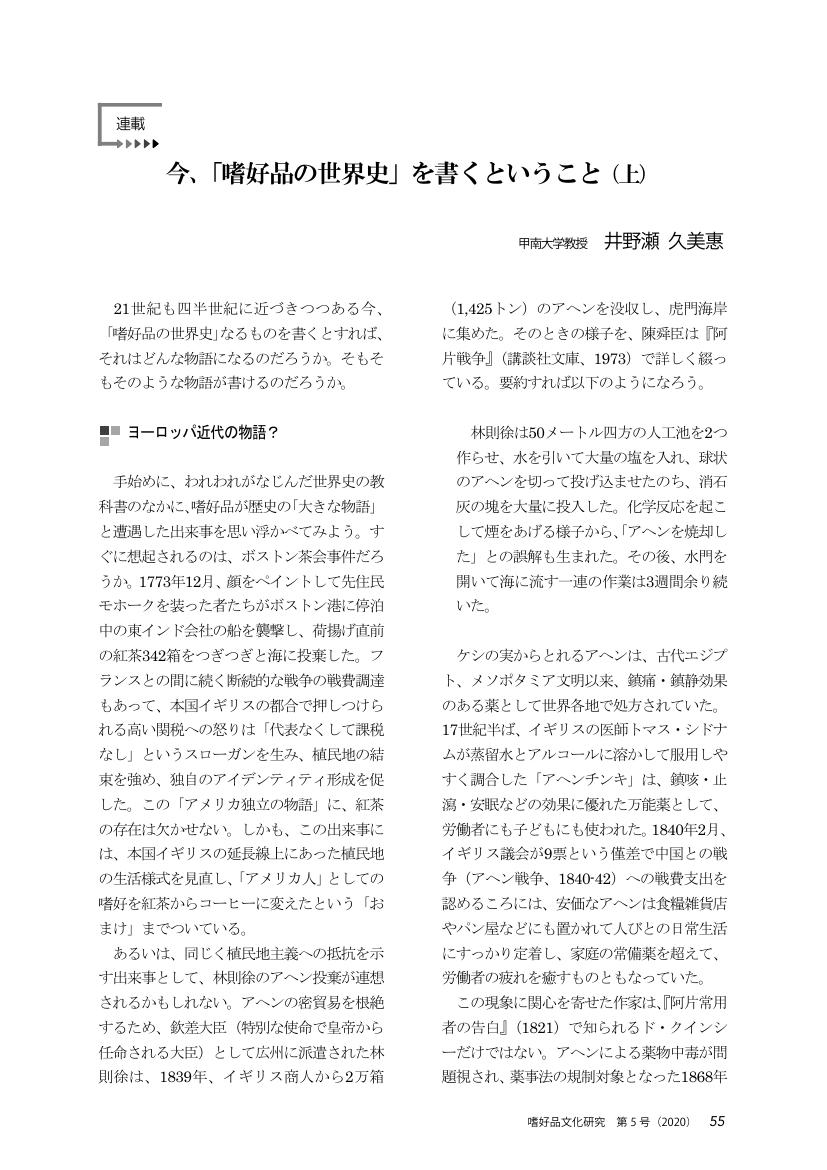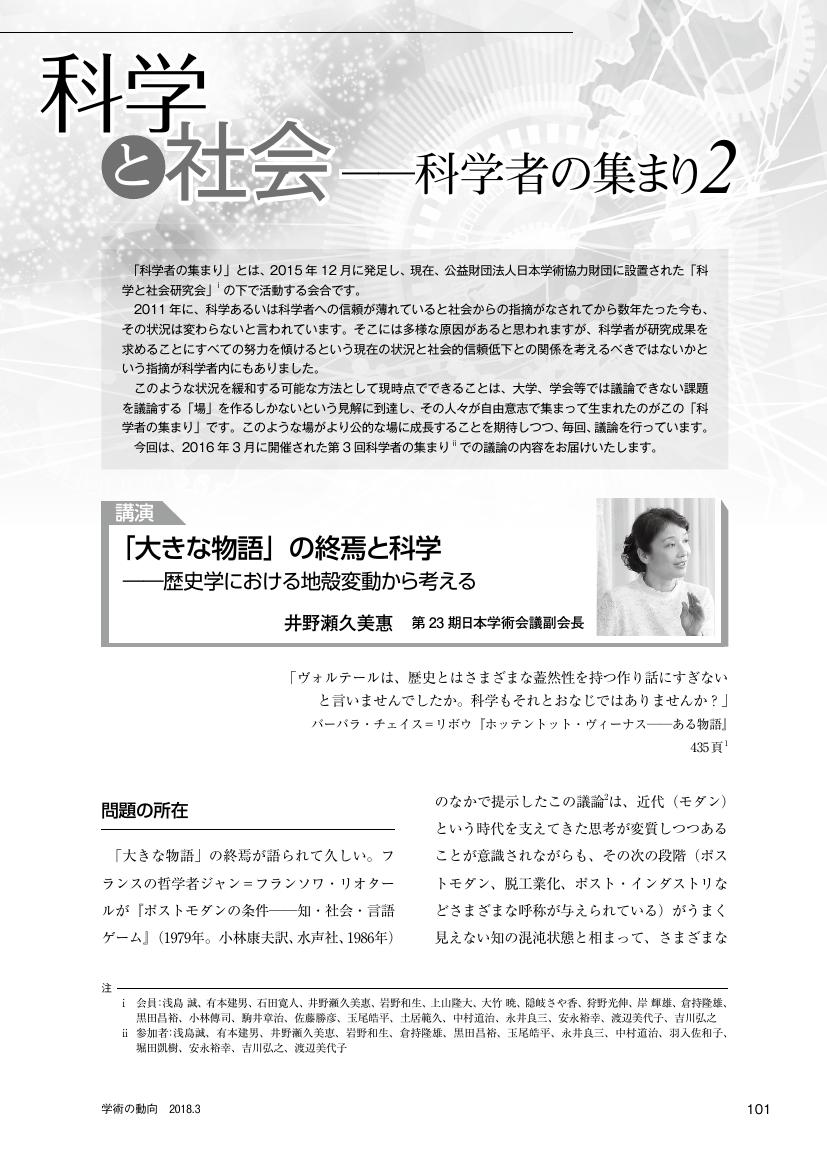7 0 0 0 OA 座談会 Gender Equality 2.0 という発想 ─誕生秘話とその後の展開
- 著者
- 鹿野 豊 井野瀬 久美惠 渡辺 美代子
- 出版者
- 公益財団法人 日本学術協力財団
- 雑誌
- 学術の動向 (ISSN:13423363)
- 巻号頁・発行日
- vol.25, no.12, pp.12_97-12_102, 2020-12-01 (Released:2021-05-01)
- 参考文献数
- 4
4 0 0 0 OA 今、「嗜好品の世界史」を書くということ(下)
- 著者
- 井野瀬 久美惠
- 出版者
- 嗜好品文化研究会
- 雑誌
- 嗜好品文化研究 (ISSN:24320862)
- 巻号頁・発行日
- vol.2021, no.6, pp.63-72, 2021 (Released:2022-06-30)
2 0 0 0 黒いヴィクトリア朝人の帝国経験-「慈悲深き大英帝国」再考
本研究の目的は、18世紀末〜19世紀初頭にかけて創造され、19世紀半ば以降に確立された「解放する/自由主義の大英帝国」「慈悲深き/博愛主義の帝国」という言説について、この帝国像の構築に重要な役割を果たしたと思われる「帝国からの訪問者」、とりわけ、奴隷解放直後のヴィクトリア朝社会にさまざまな事情でやってきて暮らした非白人、いわゆる「黒いヴィクトリア朝人(Black Victorians)」に当てて、この言説の意味と役割、その構築のメカニズムを探ることにある。多様な形態をもつ彼らのなかから、本研究が分析対象としたのは、イギリス海軍(ないし陸軍)によって現地の苦境から解放、救出され、女王(あるいはイギリス貴族)の庇護の下、(本人の意志とは無関係に)イギリスに連れてこられ、(期間の差こそあれ)ここ帝国の中心部で生活した経験を持つ非白人の少年少女たちである。救出時、10歳前後であった彼らの渡英時期は、おおむね1850、60年代前後に集中しており、彼らが言及されたコンテクストは、奴隷貿易や奴隷制度と深く絡みあっていた。この時期、アジアやアフリカの植民地(正確にはイギリスによって植民地化されつつある地域)からやってきた彼ら、特に彼らの「救出劇」がどのように語られたのかを、同時代の資料(議会報告書や外務省や植民地省への報告書、新聞や雑誌、伝道諸団体の年次報告書など)から分析し、従来の在英黒人(非白人)分析ではすっぽりと抜け落ちていた1850〜60年代が、「奴隷を解放する慈悲深き帝国」という大英帝国の自己像にとって決定的に重要であったことを明らかにした。と同時に、この大英帝国の自己像が、21世紀初頭の現在、深化するイギリス国内のポストコロニアル状況のなかで200年目を迎えた「奴隷貿易廃止の記憶」によって、改めて問題視され、再検討されている諸相を、2007年を通じてイギリス各地でおこなわれた奴隷貿易廃止200周年記念イベントの中に探り、この記億をめぐる現代都市戦略を明らかにした。
1 0 0 0 OA 今、「嗜好品の世界史」を書くということ(上)
- 著者
- 井野瀬 久美惠
- 出版者
- 嗜好品文化研究会
- 雑誌
- 嗜好品文化研究 (ISSN:24320862)
- 巻号頁・発行日
- vol.2020, no.5, pp.55-65, 2020 (Released:2022-07-29)
1 0 0 0 OA コロナ禍のなか, 過去をたぐり寄せる ──コルストン像引き倒しのタイミング再考
- 著者
- 井野瀬 久美惠
- 出版者
- 公益財団法人 日本学術協力財団
- 雑誌
- 学術の動向 (ISSN:13423363)
- 巻号頁・発行日
- vol.26, no.12, pp.12_32-12_37, 2021-12-01 (Released:2022-04-22)
新型コロナウイルス・パンデミック下で再燃した「ブラック・ライヴズ・マター(BLM)」運動は、アメリカのみならず、世界各地に拡大した。その主体である若者たちは、制度的レイシズムの根源を歴史に認め、歴史的人物の彫像や記念碑を「攻撃」し、その検証を求めた。本論考では、その最早期の事例として、ロックダウン中のイギリスで起こったコルストン像の引き倒しをとりあげ、そのタイミングを新型コロナ感染第一波と関連させて再考する。そこには、引き倒しの2日前に出された法令への「配慮」とともに、感染者数、死亡者数がエスニシティ別に公表された「コロナ禍の日常」があり、それが「イギリスの過去」を浮上させる方向へと作用していた。奇しくも日本では、引き倒しの同日、レイシズムへの無理解・無自覚を露呈する出来事が起こっていたが、それを厳しく指摘したのは歴史学者たちであった。
1 0 0 0 OA 共感の女性君主 ――ヴィクトリア女王が拓いた可能性――
- 著者
- 井野瀬 久美惠
- 出版者
- ジェンダー史学会
- 雑誌
- ジェンダー史学 (ISSN:18804357)
- 巻号頁・発行日
- vol.16, pp.5-19, 2020-10-20 (Released:2021-09-01)
- 参考文献数
- 37
As we saw in the enthronement ceremony in 2019 as well as the abdication message of the Emperor (now Emeritus) in 2016, the phrase “always staying together with the people” is characteristic of the Japanese constitutional system called symbolic monarchy. But we must be careful in interpreting what that phrase really means to the Emperor system in Japan.This paper will discuss this phrase in reference to the change in the British constitutional monarchy, partly because the British monarchy was and has been an ideal or model for the Japanese symbolic monarchy after 1945, and partly because both Emperors, Hirohito and Akihito, once confessed that they had been influenced by the British constitutional monarchy, particularly that of King George V (1910-1938). The important point is what types of monarchy George V had inherited under a constitutionally organized government from his father, Edward VII (1901-1910).In Britain, the phrase “staying together with the people” or “sympathy to the people” became widely applied to the monarchy during the reign of Queen Victoria (1837-1901), especially after the mid 1870s. This is usually discussed in relation to the idea of “the invention of tradition”, represented by the Golden (1887) and Diamond Jubilee (1897) of Queen Victoria. But the critical moment resulting in “the invention of tradition” and changing the essence of the monarchy, was during the 1860s, when the British monarchy lost one future that might have existed by the sudden death of the Queenʼs beloved husband, Prince Albert, and the Queenʼs withdrawal from public life to mourn him. This period led Walter Bagehot to write his farsighted essay on monarchy which was to be collected in his famous book, the English Constitution (1867). In addition, the peopleʼs feeling towards the monarchy also dramatically changed at that time. Since then, the importance of the monarchʼs popularity, as well as the sympathy between a monarch and the people, has grown.The monarchy the two Japanese Crown Princes observed while they visited Britain, in 1921 and 1953 respectively, and thought ideal under the new Japanese Constitution when they were Emperors, had been the one personalized and de-masculinized, even if we do not call it “feminization of the monarchy”.
1 0 0 0 OA 嗜好品と政治学[討論] 第15回嗜好品文化フォーラム(2017.5.13)報告
1 0 0 0 OA ジェンダー視点からスポーツを見直す
- 著者
- 井野瀬 久美惠
- 出版者
- 公益財団法人 日本学術協力財団
- 雑誌
- 学術の動向 (ISSN:13423363)
- 巻号頁・発行日
- vol.22, no.11, pp.11_39-11_46, 2017-11-01 (Released:2018-03-28)
1 0 0 0 「アジア・ジェンダー史」の構築と「歴史総合」教材の開発
- 著者
- 三成 美保 粟屋 利江 村上 薫 小浜 正子 鈴木 則子 小野 仁美 長 志珠絵 山崎 明子 桃木 至朗 河上 麻由子 野村 鮎子 久留島 典子 井野瀬 久美惠 姫岡 とし子 永原 陽子 落合 恵美子
- 出版者
- 奈良女子大学
- 雑誌
- 基盤研究(B)
- 巻号頁・発行日
- 2020-04-01
「アジア・ジェンダー史」の構築に向けて、次の3つの課題を設定して共同研究を行う。①「アジア≪で≫問うジェンダー史」に関する史資料の収集・整理、②高校「歴史総合」のための「アジア≪を≫問うジェンダー史」教材の作成、③アジア諸国の研究者と協力して「アジア≪から≫問うジェンダー史」研究を発展させることである。研究成果は書籍として刊行するほか、比較ジェンダー史研究会HP(https://ch-gender.jp/wp/)を通じて広く国際社会に成果を公表する。とくに②については、高校教員との対話や共同作業を通じて、ジェンダー視点から歴史教育の発展をはかるためのテキスト・資料を作成・提供する。
1 0 0 0 OA ギース (GEAHSS) の取組み ─人文学・社会科学系の挑戦
- 著者
- 井野瀬 久美惠
- 出版者
- 公益財団法人 日本学術協力財団
- 雑誌
- 学術の動向 (ISSN:13423363)
- 巻号頁・発行日
- vol.23, no.12, pp.12_40-12_43, 2018-12-01 (Released:2019-04-19)
- 被引用文献数
- 1
1 0 0 0 OA 「大きな物語」の終焉と科学
- 著者
- 井野瀬 久美惠
- 出版者
- 公益財団法人 日本学術協力財団
- 雑誌
- 学術の動向 (ISSN:13423363)
- 巻号頁・発行日
- vol.23, no.3, pp.3_101-3_107, 2018-03-01 (Released:2018-07-28)






